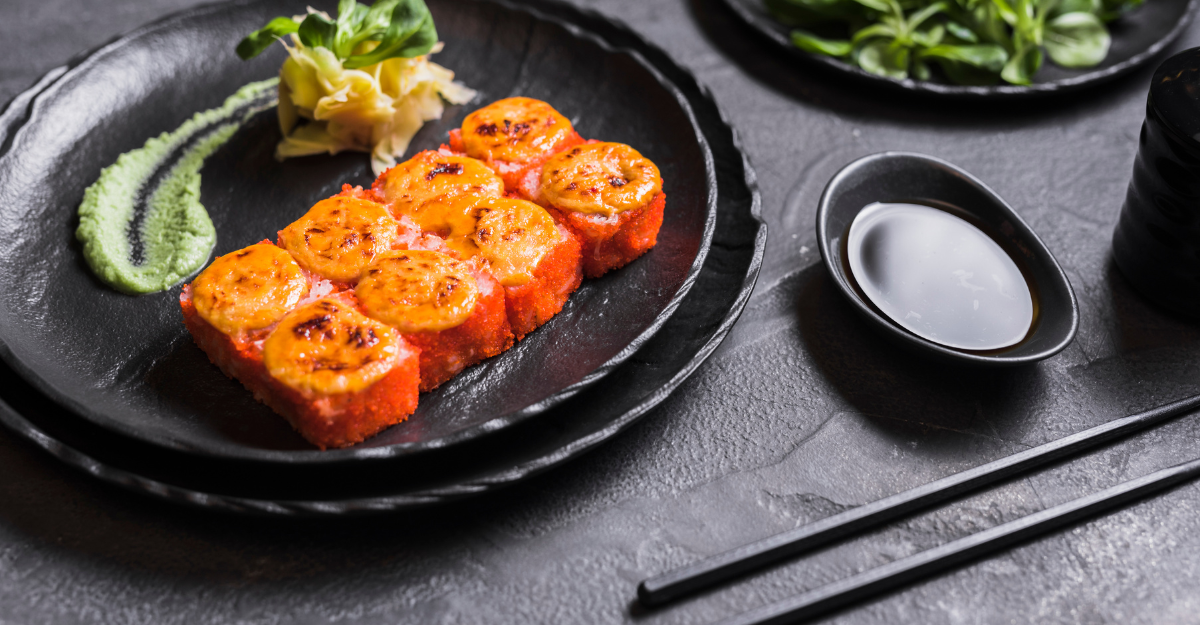Food
Salmon Maki: The Perfect Sushi Roll for Seafood Lovers

What Is Salmon Maki?
Salmon maki is one of the most popular and beloved sushi rolls worldwide. Its simplicity—featuring fresh, thinly sliced salmon rolled with sushi rice and nori (seaweed)—makes it a go-to choice for sushi enthusiasts and beginners alike. The name “maki” comes from the Japanese word meaning “roll,” and salmon maki truly embodies the art of rolling sushi into a bite-sized delicacy.
Whether you’re dining at a traditional sushi bar or preparing sushi at home, salmon maki is a versatile and delicious option that perfectly highlights the rich, buttery flavor of fresh salmon.
History
Sushi as we know it today has a long history in Japan, evolving from a preservation method for fish. However, salmon as a sushi ingredient only became widely popular in the 20th century. Norway introduced farmed Atlantic salmon to Japan in the 1980s, promoting it as safe to eat raw. This innovation reshaped sushi culture, as salmon quickly became a favorite ingredient in sushi rolls like maki.
The fusion of Japanese culinary techniques with global seafood preferences gave birth to iconic dishes like salmon maki, now enjoyed across the globe.
Ingredients in Salmon Maki
The magic of it lies in its simplicity and the quality of its ingredients. Here’s what you need:
- Fresh Salmon: Sushi-grade salmon is the star of the dish, offering a rich and delicate flavor.
- Sushi Rice: Perfectly cooked, seasoned rice adds a tangy balance to the fish.
- Nori (Seaweed): Thin sheets of dried seaweed hold the roll together.
- Optional Additions: Ingredients like avocado or cucumber can add texture and flavor.
These basic ingredients create a delicious roll, but variations allow for creativity in presentation and taste.
Nutritional Benefits of Salmon Maki
It is not only delicious but also a nutritious choice. Packed with omega-3 fatty acids, it promotes heart and brain health. Salmon is a lean source of protein, making it ideal for muscle building and weight management. The addition of rice provides energy-boosting carbohydrates, while nori is rich in iodine and vitamins.
This makes salmon maki a balanced meal option for sushi lovers who care about both flavor and nutrition.
How to Make Salmon Maki at Home
Making it at home is easier than you might think. Follow these simple steps:
- Prepare Sushi Rice: Wash and cook sushi rice, then season with rice vinegar, sugar, and salt.
- Slice the Salmon: Use a sharp knife to cut sushi-grade salmon into thin strips.
- Lay the Nori: Place a sheet of nori shiny side down on a bamboo sushi mat.
- Add Rice and Salmon: Spread a thin layer of rice over the nori and arrange salmon slices on top.
- Roll It Up: Use the mat to tightly roll the nori into a cylinder, sealing the edge with water.
- Slice and Serve: Cut the roll into even pieces and serve with soy sauce, pickled ginger, and wasabi.
With practice, you can create restaurant-quality salmon maki in your kitchen.
Popular Variations of Salmon Maki
It can be customized to suit different tastes. Here are a few popular variations:
- Spicy : A kick of Sriracha mayo makes this version perfect for spice lovers.
- Salmon and Avocado Maki: Creamy avocado adds richness to the roll.
- Smoked Salmon Maki: A unique twist featuring smoked salmon for a smoky flavor.
These variations highlight the versatility of salmon maki, making it adaptable to different palates.
Tips for Choosing Sushi-Grade Salmon
Using high-quality salmon is crucial for making salmon maki. Here’s how to choose the best:
- Look for salmon labeled as “sushi-grade” or “sashimi-grade.”
- Ensure the fish has a fresh, mild scent without any fishy odor.
- Check the flesh for a vibrant orange-pink color and firm texture.
- Buy from reputable fish markets or trusted grocery stores.
Investing in quality salmon ensures the best flavor and safety when preparing raw sushi dishes.
The Art of Rolling Sushi
Perfecting the salmon maki roll takes practice. Here are some tips:
- Use a bamboo sushi mat for even rolling.
- Keep your hands wet to prevent rice from sticking.
- Apply gentle pressure to create a tight roll without squishing the ingredients.
Mastering this technique elevates the presentation and taste of your food.
Pairing Salmon Maki with Sauces
Although it is delicious on its own, pairing it with sauces enhances the flavor. Soy sauce is a classic choice, while ponzu sauce adds a citrusy tang. For those who enjoy heat, spicy mayo or wasabi can provide a bold kick. The right sauce complements the freshness of the salmon without overpowering it.
Why Salmon Maki Is a Favorite
It is a sushi staple for many reasons. It offers a delicate balance of flavors, is visually appealing, and caters to both traditional and modern tastes. Its combination of simplicity and versatility makes it an ideal introduction to sushi for newcomers while remaining a favorite among seasoned sushi lovers.
How to Serve Salmon Maki
Presentation matters when serving it. Arrange the rolls neatly on a plate, garnish with sesame seeds or thinly sliced scallions, and include a side of pickled ginger, wasabi, and soy sauce. Serve alongside miso soup or a fresh seaweed salad for a complete Japanese dining experience.
Health and Safety Tips
When handling raw fish, follow these guidelines to ensure safety:
- Always use fresh, sushi-grade salmon.
- Keep the fish refrigerated until ready to use.
- Wash your hands and utensils thoroughly before and after handling raw fish.
- Consume sushi rolls immediately to enjoy them at their freshest.
Adhering to these precautions ensures a safe and enjoyable sushi-making experience.
Conclusion
Salmon maki is more than just a sushi roll; it’s a celebration of simplicity and flavor. Its rich taste, nutritional benefits, and adaptability make it a standout dish for any sushi lover. Whether you’re dining out or making it at home, salmon maki offers a satisfying culinary experience that’s hard to beat.
FAQs
Q: What is the best salmon for salmon maki?
Sushi-grade salmon, known for its freshness and safety for raw consumption, is ideal.
Q: Can I use cooked salmon in salmon maki?
Yes, cooked salmon can be a substitute for those who prefer not to eat raw fish.
Q: Is salmon maki gluten-free?
It can be if you use gluten-free soy sauce and check other ingredients for gluten.
Q: How many calories are in salmon maki?
A standard salmon maki roll contains about 200-250 calories, depending on the size and added ingredients.
Q: What is the difference between sashimi and salmon maki?
Sashimi is sliced raw fish served without rice, while salmon maki is a rolled sushi dish with rice and nori.
-

 Entertainment6 months ago
Entertainment6 months agoMoviesRulz: Your Ultimate Guide to Streaming Blockbusters Online
-

 Sports5 months ago
Sports5 months agoReddit Soccer Streams and Alternatives for Sports Fans
-

 Sports6 months ago
Sports6 months agoViprow.us.com Odds: Understanding Sports Betting Benefits
-

 Buisness6 months ago
Buisness6 months agoPokémon Infinite Fusion Calculator: Your Ultimate Guide
-

 Entertainment7 months ago
Entertainment7 months agoNhentai.nef: Understanding Its Role and Impact in Digital Media
-

 Entertainment5 months ago
Entertainment5 months agoIncestflix: Understanding the Controversy and Its Implications
-

 Buisness6 months ago
Buisness6 months agoThe Online Market Business in the UK: Statistics, Growth and Opportunities
-

 Technology6 months ago
Technology6 months agoDrone Review Miracoup: Unveiling Its Features and Performance
